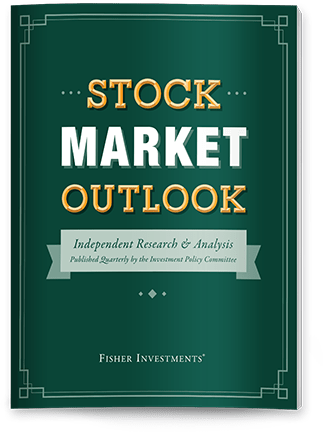Personal Wealth Management / Market Analysis
Stop Quoting Broad Market Declines in ‘Trillions of Dollars’
Big numbers always need context and scale.
As the US stock market has grown, we have noticed a weird trend growing in popularity. Where before headlines hyped moves in Dow Jones Industrial Average points, they are now dwelling on dollars. Big numbers of dollars. This week, we have seen ample talk of the S&P 500 “losing” $1 trillion in the currently four-day-old pullback. After Liberation Day, headlines sweated its $9.6 trillion “loss” since Inauguration Day. The largest companies get the same treatment, too, a perpetual preoccupation with how many dollars volatility adds to or knocks off their market cap. We think it risks leading investors to a very bad place.
When headlines describe volatility with eye-popping dollar amounts, they make the same mistake they did with focusing on Dow points: using big numbers without context. It is designed to make you click, and it can easily instill fear. $1 trillion seems like a lot of money to “erase” in four days! No human on earth has ever had that much, let alone lost that much.
But the stock market isn’t a person, so considering that drop from a human perspective won’t help. The real question: Is $1 trillion actually a lot in the grand scheme of things? To know, you have to scale. Meaning, you must find a proper reference point and assess whether $1 trillion is big or small relative to it. For the S&P 500, the correct reference point is its most recent all-time-high market capitalization.
That would be its free float-adjusted market cap on August 14. Which was … just under $54.83 trillion.[i] $1 trillion is just 1.8% of this. And even this overstates the move, because the S&P 500’s float-adjusted market cap hasn’t even dropped $1 trillion in the last four days. The index’s actual drop between August 14’s high and August 20’s close is -1.1% in price terms.[ii] Over four days. As down stretches go, this one is mild to this point.
Look, we get it, the headline writers are doing their job: jolting would-be readers into clicking. That is showbiz for you. The problems come when the same emotional response that makes people click tempts them to act. It is very easy to see these headlines, feel the wind taken out of your sails, and think you must do something, anything, to stop similarly massive sums of money bleeding out of your portfolio. But reacting to these emotions rarely proves beneficial—and success is generally a matter of luck.
Going back to that purported -$9.6 trillion S&P 500 “loss” between Inauguration Day and April 6, that is bigger than the combined GDP of Germany and Japan, the world’s third- and fourth-largest economies based on World Bank figures.[iii] That. Sounds. Big.
But at the time, the S&P 500 was down -15.1% in total return terms since Inauguration Day and -17.3% since its February 19 high, both firmly in correction territory.[iv] Both are consistent with a sharp, fleeting, sentiment-induced -10% to -20% decline, not a deeper, grueling, longer bear market of -20% or worse. Corrections tend to be steep and painful but fast, over before you know it, with a quick rebound to new highs.
When you view a market decline in percentage terms, it can nudge your brain to think through these things and make a more reasoned decision. That would have been correct, considering stocks started rebounding April 9 and were back at all-time highs by June’s end. But talk of a -$9.6 trillion “loss” may trigger the fight-or-flight instinct more often, leading to counterproductive, panic-induced moves.
For all the talk of multitrillion dollar “losses,” another key point gets, well, lost in the shuffle: A market decline isn’t actually a loss unless you sell. A correction might temporarily “erase” market value, but a recovery later can then “erase” the decline.” Which un-erases the erased value.
Similarly, a company doesn’t record a loss when its market value falls. A “loss” is only when it actually loses money because costs exceeded revenues. That big company whose name rhymes with FennSidia didn’t “lose” over a hundred billion dollars when its market cap declined that much in three trading days through Tuesday’s close. Its stock price just endured a mild decline. The kind of decline many companies have endured over three days many times over. Normal volatility. The kind where you shrug and say, “Must be Tuesday.” (Or Wednesday. Or whatever business day that ends in “y.”)
So we urge you, friends: Keep perspective. When you see market volatility portrayed in trillions of dollars being lost or erased, understand you are getting into clickbait territory. Nothing about those headline portrayals yields anything helpful to you in making a sound investment decision or rationally assessing the landscape. That requires context and scale. Slow down. Do the math. Scale. Zoom out. Add perspective. Question narratives. All the things we try to bring you regularly.
If you would like to contact the editors responsible for this article, please message MarketMinder directly.
*The content contained in this article represents only the opinions and viewpoints of the Fisher Investments editorial staff.
Get a weekly roundup of our market insights
Sign up for our weekly e-mail newsletter.

You Imagine Your Future. We Help You Get There.
Are you ready to start your journey to a better financial future?

Where Might the Market Go Next?
Confidently tackle the market’s ups and downs with independent research and analysis that tells you where we think stocks are headed—and why.





